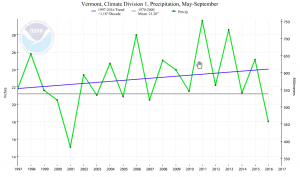With 100 acres in production and 200 acres in cover crops, Pete’s Greens in Craftsbury, Vermont invests almost more time in managing their cover crops aka “green manures” than they do their marketable crops. But climate smart farming means caring for soils, keeping carbon in the soil (not the air) where organic matter is a key factor in the production of quality crops.
As farm manager Isaac explains, “This takes a ton of time – we spend a lot of time dealing with our cover crops. You sort of think you plant it and away you go and you come back two years later. Planting soil into sod and getting the sod to die off before you go back into production is really difficult; it’s machinery intensive. So we’ve been doing multiple cover crops on different fields over two seasons. This is our third planting of oats on this field this year so we took straw off of these fields twice and that’s for mulching.” Isaac uses about 300 lbs of seeds per acre to get the density of oats he wants for green manures.
As soil guru Fred Magdoff confirms in his book Building Soils for Better Crops, “It’s not easy .. Improving organic matter content requires a sustained effort that includes a number of approaches to return organic materials to soils and minimize soil organic matter losses… All practices that help to build organic matter do at least one of two things – add more organic materials than was done in the past or decrease the rate of organic matter loss from soils.” Knowing your soil types and rates of aeration and importantly, your starting point for percentage of organic matter will let you know whether your farm is on the trajectory for climate smart farming.

